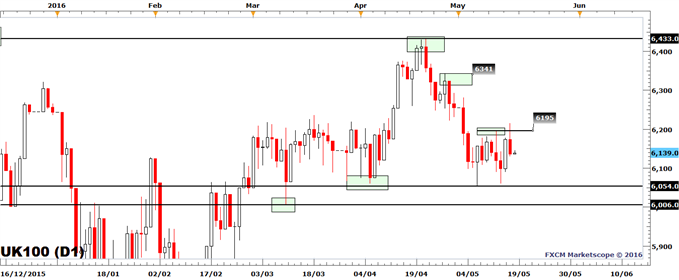Yesterday, the FTSE 100 breached the upper end of the 6054-6195 range, which kept price confined since May 6. However, as the session progressed, the price fell back into the range and closed the day near the middle of it. The slide back to the range took away some of the bullish bias.
The bullish bias of FTSE 100 traders does seem somewhat out of place if we take into consideration the fact that the German DAX 30 and S&P 500 never breached their respective ranges and instead closed near to their lower ends.
According to the business press the FTSE 100, DAX 30 and S&P 500 declined as expectations of a Fed rate hike in 2016 increased. This followed U.S. inflation increasing to an annual rate of 1.1% from 0.9%, and Industrial Production increasing by 0.7% MoM from -0.6% prior.
Technically, the outlook for the FTSE 100 is little changed. The May 6 low of 6054 and May 12 high of 6195 are keeping the FTSE 100 confined and until price leaves this range, the bias will remain neutral. Price could test either side of this range.
Resistance levels above 6195 are yesterday's high of 6217, the May 3 high of 6283 and these are followed by the April 27 high of 6341. The only strong support level at the time of writing was the May 6 low of 6053 and below it, the March 10 low of 6006 representing the next support level.
Our Stock Market forecasts for Q2 2016 are now live on the site. Download them for free.
FTSE 100 | CFD: UK100

Created with Marketscope/Trading Station II; prepared by Alejandro Zambrano
The U.K. labor market report on is on deck today, but may have limited influence on the FTSE 100, as the FTSE 100 firms sources near 80% of their revenues from overseas.
The unemployment rate may remain unchanged at 5.1%, a level that the U.K. economy has held since January, according to a Bloomberg News poll. Weekly Earnings ex-Bonus (3M/YoY) may rise to 2.3% from 2.2%, while the Jobless Claims Change may rise by 4.5k from 6.7k. We note that while the Unemployment rate has held at low levels, the number of people claiming unemployment benefits (Jobless Claims Change) rose by 6.7k to 732,100 in March of 2016. It is the first time since August 2015 that Jobless Claims figures rose and they reached the highest level since October 2012. If Jobless Claims Change keeps on rising then this implies a softer labor market, which may lead to a higher U.K. Unemployment rate.



